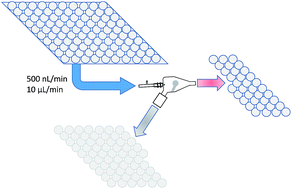Using nanoparticles to determine the transport efficiency of microflow and nanoflow nebulizers in inductively coupled plasma-mass spectrometry
Abstract
In this study we have developed a procedure that allows for the convenient determination of nebulization transport efficiency (TE%) of micro- and nano-flows used with inductively coupled plasma-mass spectrometry (ICP-MS). The approach involves the use of an aqueous suspension containing 60 nm Au nanoparticles (NPs), originating from a NIST reference material, and an ICP-MS operating in the single particle mode (short dwell times and dilute samples) for the detection of individual NPs. Various flow rates ranging from 500 nL min−1 to 10 μL min−1 using various modified pneumatic nebulizers were tested and transport efficiencies were determined. In addition, the overall system sensitivity was determined for both Au NP suspensions and dissolved metal solutions. Application of this approach has the potential to allow for the much needed TE% comparisons of the various micro-/nano-flow systems that have been developed or will be developed in the future. We anticipate that this will help micro-/capillary-/nano-liquid chromatography ICP-MS to achieve significant advancements in the areas of metallomics, metallomproteomics and proteomics.


 Please wait while we load your content...
Please wait while we load your content...